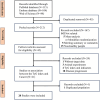The Associations Between the TyG Index and the Risk of Cancer-A Systematic Review and Meta-Analysis
- PMID: 41036596
- PMCID: PMC12489462
- DOI: 10.1002/cam4.71232
The Associations Between the TyG Index and the Risk of Cancer-A Systematic Review and Meta-Analysis
Abstract
Background: The triglyceride glucose (TyG) index, a simple and reliable surrogate marker of insulin resistance (IR), has garnered increasing attention in metabolic research. Although IR is mechanistically linked to carcinogenesis through multiple pathways, including chronic inflammation, hyperinsulinemia-driven pro-mitogenic signaling, and altered adipokine secretion, the specific utility of the TyG index for cancer risk assessment remains unclear. This systematic review examines whether the TyG index shows consistent associations across cancer types and holds value as an independent risk predictor beyond established metabolic syndrome components.
Methods: We systematically searched PubMed, Embase, and Web of Science databases from 2008 (the year the TyG index was established as an IR marker) to December 31, 2024, for studies on the TyG index-cancer association. Cohort, cross-sectional, and case-control studies were included. Using meta-analysis, we pooled effect sizes and conducted subgroup analyses by gender, region, population source, and study design. Trial sequential analysis (TSA) evaluated evidence reliability.
Results: This meta-analysis incorporated a total of 20 eligible studies. Our findings demonstrated that elevated TyG index levels were significantly associated with increased risks of various malignancies, including digestive system cancers (OR: 1.22, 95% CI 1.13-1.31), urogenital system cancers (OR: 2.04, 95% CI 1.53-2.71), and breast cancer (OR: 1.64, 95% CI 1.49-1.80) when compared to lower TyG index levels. These associations remained consistent across all pre-specified subgroup analyses stratified by study characteristics. Furthermore, TSA confirmed sufficient statistical power for definitive conclusions.
Conclusions: The consistent observed association between elevated TyG index and increased cancer risk highlights its potential as a candidate biomarker for further investigation. While these findings support the biological plausibility of insulin resistance in oncogenesis, current evidence-partially derived from observational studies-cannot establish causality or direct clinical utility. Future research should prioritize: (1) prospective validation of TyG index thresholds for cancer risk prediction, (2) mechanistic studies elucidating its role in tumor biology, and (3) assessment of its incremental value to existing risk stratification tools.
Keywords: cancer; insulin resistance; meta‐analysis; systematic review; triglyceride‐glucose index.
© 2025 The Author(s). Cancer Medicine published by John Wiley & Sons Ltd.
Conflict of interest statement
The authors declare no conflicts of interest.
Figures



References
Publication types
MeSH terms
Substances
Grants and funding
- 2023NSFSC1927/Natural Science Foundation of Sichuan
- Q21016/Medical Youth Innovation Research Project of Sichuan Province
- 81903398/National Natural Science Foundation of China
- 2023SCUH0026/"From 0 to 1" Innovation Project, Sichuan University
- YJ2021112/The research start-up fund for the introduction of talents of Sichuan University
- 2023ZYD0097/Sichuan Provincial Science and Technology Department 2023 Central Guide Local Project
- No.Emei-1841/The Sichuan Tianfu Emei Plan for Young Talents
- No.2025-2401/The Sichuan Health Commission's Popularization and Application Project
- 2025-3-Y-15/Research Project on High-Quality Development of Clinical Nutrition Work
- 2025129/Medical Research Project of Chengdu City
LinkOut - more resources
Full Text Sources
Medical
Research Materials

